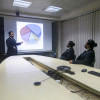The need for a workforce planning roadmap for Bangladesh and what to do

Bangladesh is expected to have a population of more than 200 million by 2036, according to Worldometer, a global data provider and real-time statistics source. The country will be a land of human mines, as its population growth rate is expected to remain between 0.96% and 1.16% over the next decade. By 2036, 100 million employment opportunities will be required to engage all employable workers in economic activities, enabling them to take responsibility for the remaining 100 million dependent toddlers, retirees, people with disabilities, and older citizens. A catastrophe awaits Bangladesh if the country cannot address key issues, including ensuring food security, maintaining economic growth, controlling law and order, and making the necessary plans to address them.
According to the Labour Force Survey 2022 by the Bangladesh Bureau of Statistics (BBS), 61.2% or 119.37 million of the 169.87 million population, was in the working-age group (aged 15 and above) at that time. 73.05 million of the 119.37 million were part of the employable workforce, and the rest were dependent groups. The 2.58% unemployment rate reported by the then-government statistics wing was highly compromised, as other reliable international sources indicated that the unemployment rate was much higher than stated. Statista and Macrotrends reported unemployment rates of 4.59% and 5.06%, respectively, in Bangladesh during the same period. This means that a population of 3.5 million or above was unemployed in 2022.
The Labour Force Survey (LFS) 2022 painted a grim picture, showing that the unemployment rate among persons with tertiary-level education was 12% in 2022, up from 11.2% in 2016-17 in Bangladesh. Whereas, the Financial Express, a national daily, published a report on October 27, 2023, stating that, according to European Intelligence Unit statistics, approximately 47% of graduates in Bangladesh are currently unemployed. Graduates are struggling hard in the job market as the conventional education system does not equip them with the skills the job market demands.
Moreover, the average skill and productivity of our workforce are significantly lower than that of other developing countries, such as Vietnam, Pakistan, India, and Sri Lanka. As a result, Bangladesh needs to hire thousands of foreign experts to run its businesses efficiently despite the massive number of unemployed graduates. Billions of foreign currencies are being spent every year to retain those foreign experts. On the other hand, Bangladesh earns only $25 billion in remittances from 10 million overseas workers, compared to almost $40 billion from 2.16 million Filipino overseas skilled workers. Both situations indicate a significant skill gap in our workforce.
Every year, 2 million youths are being added to the workforce. A few hundred thousand secure employment, but most remain unemployed. Unemployment creates poverty and social unrest. As most youths do not get desired jobs, some get derailed and involved in antisocial activities, like drug dealing, smuggling, etc. The rest find ways to make a living by pulling rickshaws, riding bikes, or selling goods on the streets or at public gatherings. The recent surge in battery-run scooters, motorcycles, and hawkers in the capital and big cities is, in a way, an indicator of the evolving unemployment situation in the nation.
Interestingly, Bangladesh has three independent measuring tools developed in line with international standards. The National Industrial Classification (NIC) of all economic activities, the Bangladesh Standard Classification of Occupations (BSCO) and the Bangladesh National Qualification Framework (BNQF). The first two classifications were developed and updated by the Bureau of Statistics of the Planning Ministry, while the Ministry of Education created the third one. Unfortunately, none of the classifications has ever been used in the history of Bangladesh to formulate a comprehensive strategy for forecasting future workforce demand aligned with industry, occupation, and educational qualification frameworks. Many initiatives were taken under different governments on a piecemeal basis, and hardly a few people benefited from those initiatives. However, the nation at large did not benefit from all these initiatives.
Bangladesh is currently enjoying a demographic dividend as the country has a larger youth workforce than the aged population. As the nation will enjoy this privilege for the next few decades before ageing pollution becomes a concern, this is the last opportunity to formulate a comprehensive workforce plan, at least for the next ten years. Creating employment opportunities for a hundred million people is a challenging task. As the supply side is already estimated, Bangladesh needs to assess its resources and its capacity to increase the demand for the required workforce.
Ensuring the balanced nutrition and food security of 200 million citizens would be the most challenging part. Bangladesh needs to reassess its total cultivable land, including river and sea islands, to produce food grains, vegetables, fruits, animal feed, industrial crops, poultry, meat, dairy and fish. Every inch of its land needs to be utilised scientifically and organically to produce maximum output and reduce import dependency. A well-planned strategy is necessary to estimate the number of workers required in agriculture, fishing, and forestry, as well as the level of skill and educational competency needed.
Given the high population density and growth rate, Bangladesh should continue to prioritise labour-intensive industrial policies. The agri-processing, frozen food, leather, tea, jute, and rubber industries should be the top priorities, as Bangladesh has the resources to benefit from these industries. The second priority is to be given to labour-intensive, export-led industries, including ready-made garments, home textiles, footwear, towels, electronic appliances, electric fittings, hardware, computer peripherals, mobile handset and accessories, handicraft, shipbuilding, plastics, ceramics, light engineering, auto parts, and other allied manufacturing and assembly facilities. The third thrust sector should include import-substitute industries, such as fertiliser, animal feed, pesticides, medicines and vaccines, cement, ceramics, glass, cables, light fittings, paper, boards, chemicals, paints, tools, kitchenware, cutlery, and all other feasible industries. Bangladesh needs to estimate the size of the potential industries, the number of workers, and their competency requirements. We need to update the syllabi of the various industrial courses offered at vocational training centres and ensure adherence to global standards in developing the industrial workforce.
Currently, most of the workforce worldwide, including in Bangladesh, is engaged in the service sector. As the world has entered the fourth industrial revolution, Information Technology, especially artificial intelligence, will dominate the world. Outsourcing and freelancing have created immense scopes to engage and employ millions of highly educated youths in these arenas. All colleges under the National University should offer Information Technology (IT) and Internet of Things (IoT) related courses to prepare millions of graduates for self-employment. All universities in the country should also offer market-driven courses to prevent the creation of graduate unemployment.
Remittance is one of the essential four pillars of Bangladesh's Economy. It contributes a significant share of foreign currency earnings and retains the national foreign exchange reserve threshold. However, Bangladesh cannot fully realise its potential due to the lack of skills and language proficiency among its overseas workers. Policymakers need to identify new overseas job markets, develop trainers, build the capacity of training centres, and ensure the high quality of the training outcomes for passing trainees. Soon, there will be a massive demand for nurses, caregivers, electricians, plumbers, carpenters, and industrial operators in developed countries. Bangladesh needs to create a master plan to assess the overseas workforce requirement and develop skilled workers in relevant trades.
Bangladesh needs to develop a comprehensive workforce planning roadmap to accommodate 100 million workers over the next decade. The roadmap must comply with industrial classifications, occupational classifications, the educational qualification framework, the diversification of human resources in the rural economy, and increased female engagement in core economic activities. If Bangladesh could address one of its core problems, unemployment, other significant issues, such as poverty, pollution, and corruption, could be significantly reduced.
Views expressed in this article are the authors' own.
The author is a writer, researcher, and teacher. He is currently working as an assistant professor (adjunct faculty) at BRAC University.

 For all latest news, follow The Daily Star's Google News channel.
For all latest news, follow The Daily Star's Google News channel. 








Comments